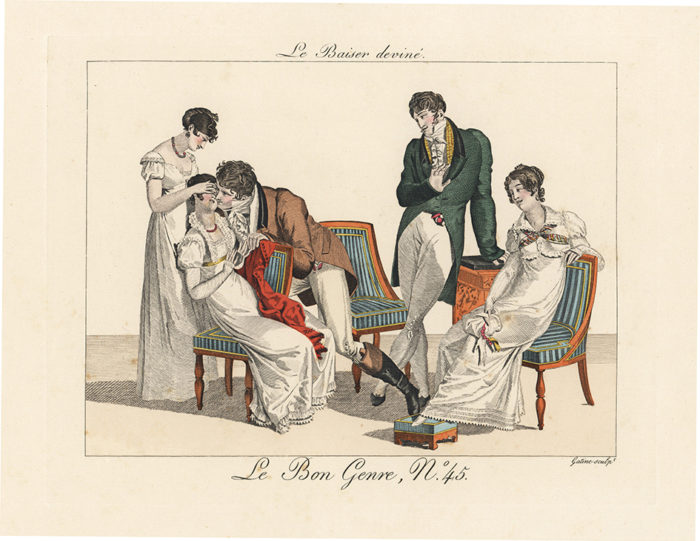British games: A brief history of British pastimes
Martha Alexander talks us through a brief history of British games and pastimes, from bladder football, to cockfighting…
No matter what part of British history you look at, there is evidence that people weren’t short of British games to keep them entertained, no matter how limited their finances and despite non-existent technology. From the Middle Ages onwards, if you were royal or noble – which is to say rich – you typically had plenty of time on your hands to dedicate to hunting, gambling, and parlour games. The working classes had a lot less free time: clocking off, weekends and annual leave are all relatively modern concepts. But that didn’t mean they never found the time to roll some dice or kick a pig’s bladder about.
Games and activities often denote class – that was the case hundreds of years ago and it is the case now –while others are universally inviting, whether played in a workhouse or at Court. Some were cruel and violent, others endearingly silly. But all, from gambling to jigsaw puzzles, give us fascinating insight into how the leisure time of yesteryear was spent.
British games: Bladder football
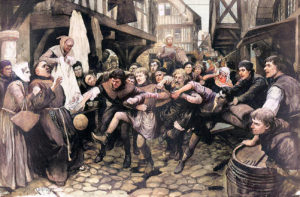
The beautiful game has been played for centuries in England although its origins are less than glamorous. During the medieval period, football was essentially a lawless contest that saw mobs from different towns battling to kick and hit a ball made from a pig or sheep’s bladder – inflated by lung power like an organic balloon. Fighting among players was common.
Henry VIII loved a spot of football – and is said to have owned the first pair of football boots. However, he banned it for being uncivilised – a decision that coincided with his declining health and athleticism.
However, football remained widespread and continued to be a rough and violent game until the mid-1800s when rules were standardised by English public schools. This paved the way for a comprehensive set of rules to be established across the UK.
British games: cat’s cradle
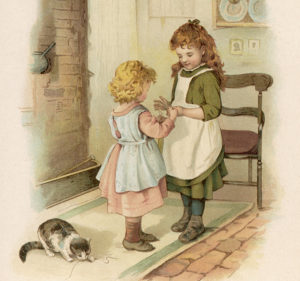
One long piece of string tied into a loop and passed between pairs of hands in ever-changing formations – Cat’s Cradle manages to be both remarkably simple and mind-blowingly complex. Versions of it have been played all over the world for thousands of years, with names including ‘turning rope’ in China and ‘Jack in the pulpit’ in parts of America. The first mention of it in English history is within The Light Of Nature Pursued by Abraham Tucker in 1768 and it is still enjoyed in playgrounds today. It is thought that it might have once been known as ‘Catch’ Cradle – and been misreported over time.
British games: parlour games
As the name suggests, these were games for playing indoors and typically involved talking, often with an emphasis on memory. They are often believed to have started in the mid-19th century but Professor Catherine Richardson, Professor of Early Modern Studies at University of Kent, argues that their prevalence goes back further.
“The idea of playing games in the parlour actually goes back to 16C, when the ‘middling sort’ (those who became the middling class a bit later) designed their parlours as special spaces which were very highly decorated… and invited their neighbours of a similar status around for evenings of entertainment,” she explains.
“They were able to do this because they could afford to light their rooms after dark, which was the start of a domestic leisure economy.” Professor Richardson also points out that there were many attempts to quash entertainment by those in power. “James I tried to legislate on some of these issues around entertainment, as did others before him,” she explains. “There’s an extensive outraged moral literature about people who play games and gamble in alehouses, but doing it at home was much more respectable!” It is fair to say that parlour games reached their zenith during the Victorian period.
The Minister’s Cat is where the eponymous cat is repeatedly described using adjectives beginning with specific letters of the alphabet while Reverend Crawley’s Game saw players stand in a circle and join hands, except not with a direct neighbour. The result was a human knot that needed untangling – making it a rather risqué game. Sardines – cousin of Hide and Seek – was also much played during the Victorian period, as was Consequences – a written game where each player must contribute a line to a story without knowing what has gone before.
British games: Blind Man’s Buff
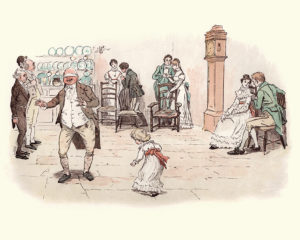
With one player blindfolded and tasked with ‘finding’ the other players who have the advantage of sight, Blind Man’s Buff is one of many parlour games hinged on sight – or lack thereof.
Squeak Piggy Squeak is a faintly ridiculous game that involves a blindfolded ‘farmer’ who sits in the centre of a circle of ‘piggies’ and must place a pillow on the lap of any of the surrounding piggies and then sit themselves on top of it. The piggy must squeak and if the farmer identifies him or her correctly, the piggy becomes the farmer.
Are You There, Moriarty? involves two blindfolded players, both of whom must repeat the refrain ‘are you there Moriarty?” and respond to it by trying to whack one another over the head with a rolled-up newspaper. Whoever gets hit first of the pair is ‘out’ and replaced by another player.
British games: puzzles
The jigsaw puzzle was invented by cartographer John Spilsbury in 1762, who mounted a map onto wood and cut around the countries. The puzzle was given to a local school as an educational aid and its genius soon spread. By the late 1800s, puzzles went through a surge in popularity. Around this time, the jigsaw tool was invented and used to efficiently cut through wood, making it possible for puzzles to be more precise and intricate. This is how they got the name we all use today – prior to this they were known as ‘dissected’ puzzles.
British games: Dice
The humble dice has been used across the world for thousands of years as the basis for uncountable games of chance – from children’s play to high-stakes betting.
In medieval London, dice would typically have been made from bone – and ‘loaded’ dice were not uncommon. There were lots of different games, but one of the most popular was Hazard, where the outcome of each roll of two dice could be bet on, and the aim was to roll a double. Despite its prevalence, betting on dice was deeply frowned upon by the Catholic Church and certainly not a game for ladies to play.
By Georgian times dice games were played by aristocrats. Despite their status, they weren’t above cheating. Loaded dice made their way onto any table. Dice, like all games of chance, are at the mercy of luck – something David Flusfeder Senior Lecturer at the University of Kent, and author of LUCK: A Personal Account of Fortune, Chance and Risk in 13 Investigations knows plenty about.
“The word ‘Luck’ was invented by 15th-century English gamblers,” he says. “God was receding from the universe, and they needed a word to account for that seemingly capricious force that intervenes between desire and its consummation, either for good or for ill.”
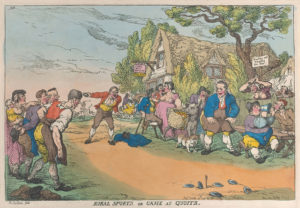
British games: Cockfighting
Brutal and cruel, cockfighting or ‘cocking’ – where two gamecocks were placed in an arena known as a cockpit and forced to attack each another to death in front of a baying crowd who bet on the outcome – was thought to have been introduced to Britain by the Romans.
However, its popularity was particularly notable from the Tudor period until the early-1800s. It was taken extremely seriously by those involved: cocks would be trained and given a special diet. Sometimes owners would add sharp metal spurs onto the legs of their birds, which would help them to maim their opponent more viciously. Cocking transcended class – you could find a cockpit anywhere, from palaces (Cockpit Steps in London was once part of a royal cockpit) to provincial villages – and was apparently entirely acceptable until the early 19th century when the Society for the Prevention of Cruelty to Animals was founded, bringing about a slow but steady change in attitudes towards cockfighting. The ‘sport’ was made illegal in 1849, although sadly there are reports that it still happens in the UK today.
This is an extract, read the full feature in the Dec/Jan 2022 issue of Discover Britain, out on 4 November.
Read more:
Nominate your British heroes: Who do you think has shaped our nation?

